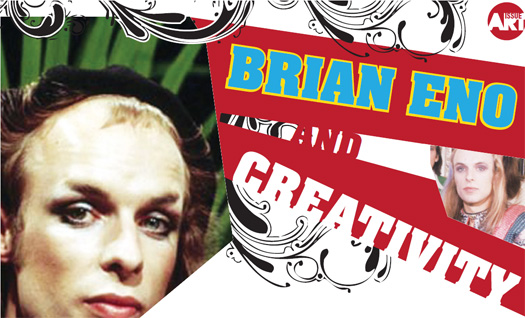Brian Eno and Creativity

It's curious to see how few people around this campus know about the impact that Brian Eno — or formally, Brian Peter George St. John le Baptiste de la Salle Eno — has had on music and the creative recording arts.
Indeed, since joining the English band Roxy Music in the early 1970s, Eno has been producing music the likes of which fit the upper end of the proverbial bell-curve. In addition to pioneering (and naming) ambient music, he is arguably the most sought-after record producer in the world.
"One often used to hear high art people saying that pop music was so boring and formulaic. I never thought that was true," he said in an interview with Peter Halley in 2002. "All that formula and repetition is like a great big vehicle for carrying the moment of difference — the tiny point where something happens that didn't happen before. As a listener, the first question I ask myself is, 'Why am I moved by that? Why does that difference matter to me?'"
Eno's genius is often considered a result of his ways of thinking against the grain — he prides himself in his ability to take outside perspectives and apply them to the process of composing and producing music, as chaotic and seemingly random as he admits that sometimes can become.
"It's interesting that within one head there can be this childlike fascination with doing everything and the adult saying, 'Why don't you ever tidy up in here?'"
Regardless of what kind of music you prefer, you've likely heard his work — as far back as David Bowie's Berlin Trilogy through most every U2 record, to more recent work with Coldplay and Natalie Imbruglia, Eno is widely considered godlike.
Even artists who have never worked with Eno take immense inspiration from his processes and massive catalogue of music. Take MGMT, whose song Brian Eno from their 2010 release Congratulations is an unabashed tribute to the producer: "I can tell that he's kind of smiling/But what does he know?/We're always one step behind him/He's Brian Eno."
"I think if there is an influence, it's not in terms of style so much but in terms of approach to working. For instance, some quite odd people have said, either in interviews or directly to me, that they were influenced by me," Eno said to Joshua Klein of music website Pitchfork in 2009. "Hank Shocklee, from Public Enemy, said that their whole thing really started with [David Byrne's 1981] My Life in the Bush of Ghosts. So that's a very surprising connection, I think."
One particularly fun piece of trivia is that Eno also wrote "the Microsoft Sound," that six-second start-up sound with the swoosh of music and the plunky piano bit that came when you turned on your PC with Windows 95.
In 2008, Eno even collaborated with musician Peter Chilvers to produce Bloom, an iPhone/iPod Touch application for the exploration of music and sound and design with one's fingertips. Indeed, the world has looked to Brian Eno for inspiration for decades.
Not that he's abdicated from the world of music — in 2009, reports from the studio in which Coldplay were working detail very Eno-esque strategies in place to inspire new music and experimentation, testament to the unique vision of the man himself. Written by "Roadie 42," the journal describes sessions without front man Chris Martin, who was banned from the studio as an experiment by Eno.
"Rather than have Chris's demo recordings come in fully-formed, leading the songs in a particular direction," it described. "Will (Champion, drums), Guy (Berryman, bass) and Jonny (Buckland, guitar) are constructing their own musical underpinning with little idea of what Chris had in mind. For many of the tracks, they hear nothing but the vocal track."
"Often, they come in first thing in the morning and listen to Chris's idea once, before going out into the live room and working up something based purely on how the song 'felt' to them on first listen," it continued. "When Brian makes the move to his laptop and brings Chris's voice back in, the familiar Coldplay melodies and emotions are loud and clear, but the canvas they are set against has become wider, more vivid and even more daring — like a new band that's just got together. The results are quite astounding."
If there's anything that can be learned from Brian Eno, it's the idea of approaching a challenge intellectually and from multiple perspectives. A world away, design writer Michael Bierut put it very well in 1989.
"It's possible to study graphic design for four years without any meaningful exposure to the fine arts, literature, science, history, politics, or any of the other disciplines that unite us in a common culture," he wrote. "Every problem has a purely visual solution that exists outside any cultural context."
However, he warned of the sterility that comes from ignorance to culture. "In a vacuum that excludes popular as well as high culture, the meaning of the mark in its culture is disregarded."
So don't miss the lesson — invest yourself creatively in your work, and often. Whether you study art, music, or anything in between, consider a given challenge beyond just the straightforward problem, and question what the underlying meaning of the problem is — then not only will you get the most from your work, you'll take it to places that no one else will.













